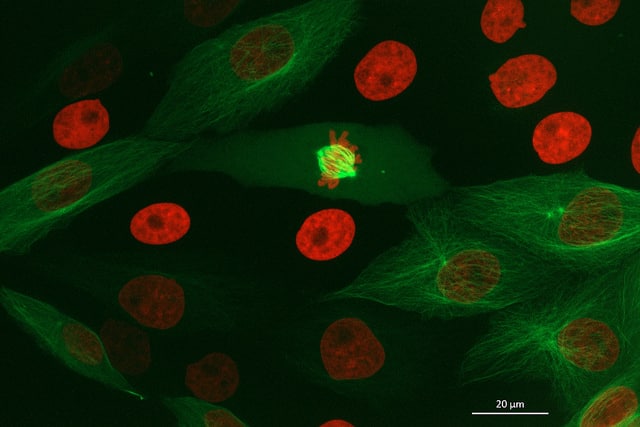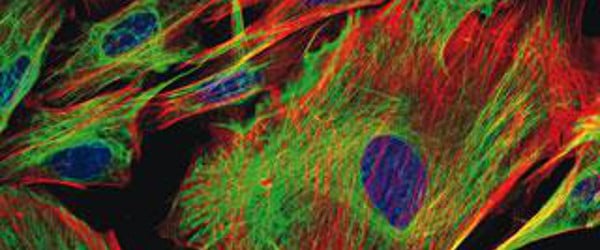When you fix your tissue samples with paraformaldehyde (PFA) the proteins in your sample become covalently cross-linked. This is good to preserve the ‘architecture’ of your tissue sample. However, this cross-linking can become a problem when you carry out immunohistochemistry (IHC).
Cross-linking can ‘mask’ or hide your antigens-of-interest and make them ‘invisible’ to your IHC detection antibody. This is where ‘antigen retrieval’ or ‘unmasking’ is essential to know.
For over 20 years I worked in the field of contraceptive vaccines examining sperm/egg recognition. Much of my work involved IHC on PFA fixed tissue. During this time some of the proteins I was interested in proved very difficult to detect and image. That was when our histology labs introduced to me what seemed to be a bizarre technique: Cooking the slides in a microwave before carrying out the IHC.
But strange as it was, cooking my slides worked! It transformed my IHC results. Soon “cooking my slides in the microwave” became a routine part of my IHC protocol.
But heating is not the only way to unmask antigens. Proteolytic enzymes can also be used to great effect. So, why and how does heating and proteolytic enxymes work to retrieve antigens in tissue samples?
To answer this, first we need to go review what happens to tissues during PFA fixation. In brief, during fixation PFA reacts with protein’s amine group forming an intermediate ion. This intermediate then reacts with the phenol group of tyrosine residues creating covalent bonds and cross-linking your protein to itself and other proteins, fixing the ‘architecture’ of your tissue sample. This fixing can bury, hide or otherwise ‘mask’ your proteins-of-interest, dampening its immunoreactivity.
How: The Mannich Reaction
It was originally thought that heat or enzymes were responsible for simply breaking down the cross-links formed between proteins during PFA fixation. However, it seems to be slightly more complex. In a paper published in 20071, it was proposed that the ‘Mannich Reaction’ was involved. This paper proposes that antigen retrieval actually removes the cross-links proteins that otherwise interfere with antigen recognition.
However, there is still speculation surrounding this technique.
Your Choice: Two Retrieval Choices…or None At All
You do not always need to add a retrieval step to your IHC protocol. If you are using an antibody which recognises multiple antigens, for example if you are using a polyclonal antibody, then you should get good results without unmasking (although with a polyclonal you will contend with more background staining).
But if you need to carry out antigen retrieval, you have two choices: heat or enzymes. If your tissue is particularly fragile, then I would suggest a heat-retrieval method. Some of the enzymes used for unmasking can have a destructive effect on tissue, not only changing the tissue ‘architecture’, but possibly even destroying the antigens you are trying to detect and image (not good).
Choice 1: Proteolytic Induced Epitope Retrieval (PIER)
The three most common enzymes used in ‘Proteolytic Induced Epitope Retrieval’ (or ‘PIER’) are Trypsin, Pepsin and Proteinase K. Trypsin works well for most tissue types and with most antibodies, but check the antibody data sheet first.
There are two methods for carrying out PIER:
- The first is to add the enzyme directly on to your slide,
- the second is to place your slides in a rack and immerse in a staining dish containing the enzyme.
The first method uses less enzyme, however it takes time to add enzymes to slides, so if you are processing a lot of slides take this into account, as timing is critical in PIER.
The enzymes used in PIER usually need a 10–20 minute incubation at 370C. Maintaining this temperature is easy if you choose the immersion method (method 2), just place your staining dish in a cell culture chamber or water bath. However, if you choose the first method of directly adding your enzyme, a 20 minute incubation is long enough that evaporation becomes a concern. So if this is your choice make sure you do it in a humid chamber.
Sample PIER Protocol (with Trypsin)
Materials Needed:
- 0.5% Trypsin Stock Solution. To make dissolve 50 mg of Trypsin in 10 ml of dH2O water. Store at –200C.
- 1% Calcium Chloride Stock Solution. To make dissolve 100 mg of calcium chloride in 10 ml of dH2O. Store at 40C.
- 0.05% in Calcium Chloride Solution ‘Working Solution’. To make add 1 ml of the 0.5% Trypsin Stock Solution and 1 ml of 1% Calcium Chloride Stock Solution to 8 ml dH2O, Adjust the pH to 7.8 with NaOH. Store at 40C for up to one month. This Working solution is what you will put your enzyme in.
Method:
- Dewax and rehydrate your slides. See this H&E article for more details about dewaxing and rehydrating.
- Add your enzyme. If pipetting directly onto your slides, pre-warm your Working Solution then add it to the sections on your slides. Then incubate in a humid chamber in a 370C cell culture chamber for (your experimentally determined) desired time. If immersing your slides pre-warm your buffer and slides/rack. To warm your slides/rack fill a staining dish with ultrapure water, sit this in your water bath and add the rack and slides.
- End reaction. After the desired time, remove slide from the enzyme and place under cold running tap for three minutes. Your retrieval is complete. Continue on with the rest of your IHC method.
Choice #2: Heat-Induced Epitope Retrieval (HIER)
Although most of the early methods of ‘Heat-Induced Epitope Retrieval’ or HIER used microwave ovens, now pressure cookers are widely used. It is even now possible to purchase scientific microwave ovens that are primarily designed for HIER. These are ideal as some, especially older domestic ovens models, may have cold spots and are designed for heating food- not tissue sections and glass!
During the process of HIER, heat causes the protein cross-links formed during fixation to break and the original protein structure to unfold. The buffer used during this heating is also important, as it further helps unfold the proteins.
As with PIER, the HIER method is temperature and time sensitive (as well as pH sensitive), so always use control slides to optimise the method before using your samples.
Sample HIER Protocol (Sodium Citrate/Pressure Cooker)
This is one of the most common retrival methods and is suitable for a wide range of IHC methods.
Materials Needed:
- Sodium Citrate Buffer. To make mix 2.94 g of Tri-sodium citrate (dihydrate) in 1 litre dH2O. Adjust pH to 6.0 with 1N HCl. Add 500 ml of Tween 20 and mix well. Store at room temperature for three months or 4°C for up to six months.
Method:
- Dewax and rehydrate slides.
- Add the Sodium Citrate Buffer to your pressure cooker (enough to cover the rack of slides). Place the pressure cooker on a hotplate. Do this in a fume hood!
- Cook your slides. Turn the hot plate on to its maximum setting. When the buffer is boiling, carefully place your rack or slides in your pressure cooker. Place the lid on your pressure cooker. Then when the cooker has reached pressure, set a timer for three minutes.
- Open the pressure release valve. After three minutes, turn the hotplate off. Place the pressure cooker on the metal surface of the fume hood. Open the pressure release valve. Be careful of the very hot steam! And allow the pressure cooker to cool for 20 minutes.
- Open lid. Transfer the pressure cooker to a sink and carefully open the lid. Run the cold tap into the cooker/slides for five minutes. Your retrieval is complete. Continue on with the rest of your IHC method.
So that is it for my brief overview of PIER and HIER. Both or either of which can dramatically improve your IHC results. Keep in mind that whenever you are dealing with IHC steps you will need to experiment with conditions, exacts times, and concentrations, etc. to find your best result. And as always, be sure to try out any new retrieval methods on control tissue before using any precious samples!
References
1. Leong TY, Leong AS (2007) How does antigen retrieval work? Adv Anat Pathol. 14(2):129–31.







